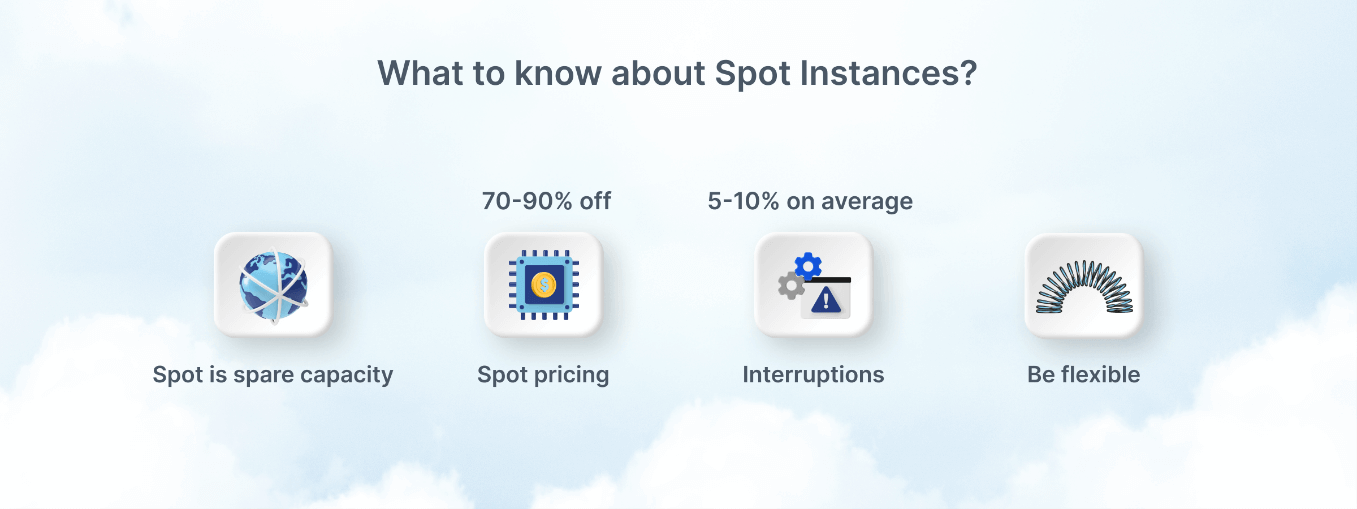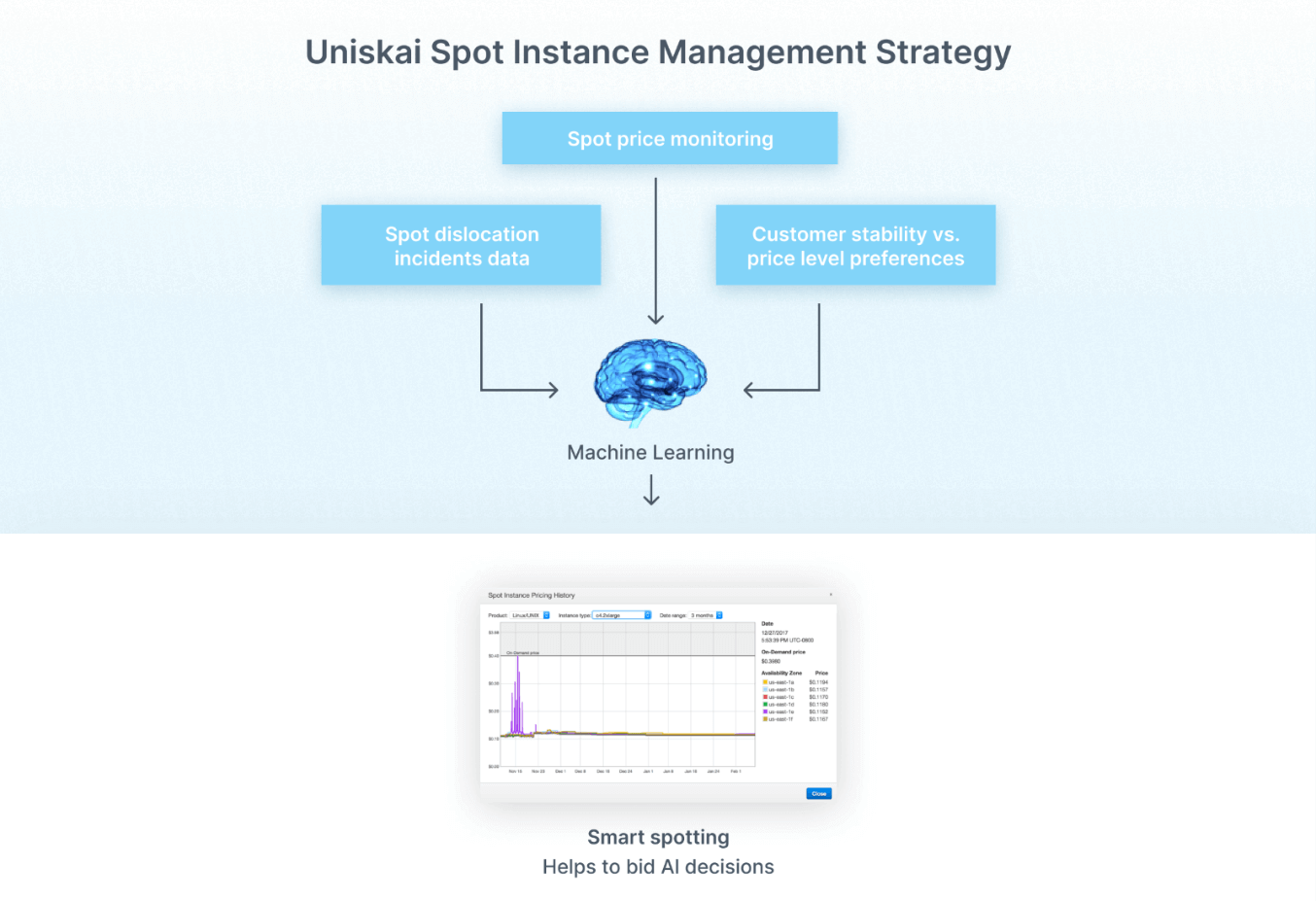Spot Instance strategy applicable to mission-critical workloads that can save up to 90% in cloud spend

Spot Instances are typically the most cost-effective computing option, proposing up to 90% discounts compared to pay-as-you-go pricing. Despite cloud providers offering impressive spot discounts, most companies do not take full advantage of this savings opportunity. For instance, only 28% of AWS users convert their instances into spots, according to Flexera's cloud report 2022.
Cloud Service Providers (CSPs) use Spot Instances to sell their unused resources. However, one tricky detail is that spots can be disconnected and taken back in the shortest possible time – anywhere from two minutes to as little as 30 seconds. As a rule, spot mode can only be used for stateless, error-liberal workloads or processes that can be stopped and restarted to avoid dealing with mission-critical caseloads. Here we will talk about a unique Spot Instance management strategy you can confidently apply to business-critical workloads since it's one of the most effective practices in the cloud cost optimization master plan.
What is a Spot Instance, and how does it work?
A Spot Instance is an instance that uses available capacity and is offered by all the three major CSPs: AWS, Google Cloud, and Microsoft Azure (in Google Cloud, it's called Preemptible Instance) at a price below the on-demand price. With Spot Instances in hand, you can notably reduce your cloud costs by paying Spot Price (well-modified to term and demand) hourly. For example, AWS Spot Instances are up to 90% cheaper than On-Demand Instances and can lead to massive cost savings. However, Spot Instances can be revoked by vendors at any time after a brief push notification that gives you from 30 seconds to two minutes to do something about it.
How do Spot Instances work?
Send a request for a Spot Instance and set the maximum price you're willing to pay for it. If the amount you've selected does not exceed the spot pricing, and the required capacity of the computing power is unused, the provider will allow you to launch the spot. The instance is not supposed to start working if the price you set is lower than the rate for this particular spot.
Here's a tip: To maximize your chances of getting a Spot Instance, ensure your maximum spot price is as close to the on-demand price as possible. If you achieve it at a much lower rate, and Spot Instance prices increase, so too does the risk of your workload being interrupted.

Additionally, keep track of the different instance types and be flexible. You can change the instance type, and there can be various options. A flexible approach to instance types and Availability Zones for deployment gives spots a more comprehensive range of alternatives for detecting and allocating the appropriate load of computing power.
How often are Spot Instances interrupted?
A logical question arises: How often do vendors take Spot Instances back? Fortunately, the answer to this question is quite comforting as Spot Instances are only interrupted at about 5-10% on average. This percentage varies significantly based on the Availability Zone and instance type you are using. To get an idea of how often your instances may be interrupted, AWS proposes you use their Spot Instance Advisor.

Spot Instances and business-critical workloads
For more than a decade, CSPs have been offering their unused resources at a discounted price in the form of Spot Instances on one condition – a sudden instance closure notice can pop up at any moment, only giving you a two-minute/thirty-second notification of the closure. Amazon gives you two minutes, and Microsoft Azure and Google Cloud only 30 seconds. Is that enough time to drop everything and find a replacement for your instance? Of course not. The best and the only way to handle sudden Spot Instance interruptions is through well-architected automation. For example, AWS experts propose leveraging capacity rebalancing as it will help maintain workload availability by proactively increasing your Auto Scaling group (the instance you're planning to spot has to be attached to it) with a new Spot Instance before an active Spot Instance receives its interruption notice.
But there is another way
Let’s talk about an innovative solution that can effectively manage Spot Instances and maintain the availability you require thanks to its hazard assessment technology and proactive steps that must be taken before any termination takes effect.
Profisea Labs’ experts have designed Uniskai to enable users to visualize and optimize their cloud infrastructure and take control of their cloud. Uniskai's innovative approach is based on a visual representation of all the company's cloud assets, combined with comprehensive AI-based cost optimization automation that works together so customers can detect unused areas and make savings decisions quickly and securely.
Uniskai's Spot Instance management strategy
In terms of savings, Profisea Labs' experts combine all the best practices in cloud cost optimization into a unified, unique saving strategy where Uniskai releases or downsizes any unused capacity, suggests and manages AI-based scheduling policies, reduces costs with a patented spot management technology, and manages reservations with a smart offering, helping Uniskai's customers save up to 90% of their cloud spend.
The Spot Instance management strategy from Uniskai includes:
- Spot pricing monitoring which helps the system make a bid that factors in the default maximum price (the On-Demand price) and the Spot price history for the last 90 days, all of which it filters by instance type, operating system, and Availability Zone (all done automatically).
One-click spot converting. Uniskai's customers easily convert (no extra activity required) on-demand machines, Autoscaling Groups, and Kubernetes clusters into spots and manage both stateless and stateful architectures in one and the same dashboard.

- Spot termination prediction. Intelligently scheduled spots allow machine learning algorithms to see the pattern in which it is best to update spotted machines. Uniskai tries to minimize downtime, using our smart scheduling based on machine learning models capable of working with stateful and stateless spots.
Continuous management of Spot Instances. Uniskai's technology allows systems to promptly locate when changes occur, while appraising the instance termination risk level, and then applying the appropriate reactions to maintain a 99.9% SLA (Service Level Agreement). The reaction is proactive redeployment to equivalent Spot Instances carried out while the 'hazardous' machine is still operating, thus decreasing the potential downtime of any service operating on Spot Instances. But, with all this, the instance doesn't have to be attached to the Autoscaling Group.
The User sees that process as a one-minute restart. Uniskai by Profisea Labs can effectively manage spot instances and maintain the required availability owning to its proactive steps taken before any termination takes effect.

- Spot Instances' intellectual scheduling. Cloudsitter sets up automated hibernation for your on-demand/Spot Instances, databases, Autoscaling Groups, and Kubernetes clusters to optimize virtual resources usage and save cloud computing costs.
- Customers' stability and price preferences are taken into consideration. Uniskai's well-architected solution can be prepared for the abrupt termination of Spot Instances and coupled with spot pricing monitoring, results in a powerful Spot Instance Management Strategy that includes their continuous monitoring and management, complemented by their intellectual scheduling to save up to 90% of cloud costs.

Final thoughts: Heading to a trouble-free cloud Paradise
As the growing popularity of the public cloud continues to accelerate, cloud cost sprawl and cloud waste continue to skyrocket. The enormous spike in cloud spend is not fresh news, yet it continues to be of great concern to organizations. This is probably because about 90% of companies spend more than a million dollars a year on cloud services, often because they do not fully grasp how to manage cloud budgets effectively and how to develop cloud cost strategies. Cloud cost management should be as much a part of a project’s life cycle. It is no less important than the implementation of sound FinOps practices during project/product development.
Clearly, a ‘one-fit-all' solution cannot save the day, best expressed by Oleksii Glib, CEO at bespoke software development services company, Acropolium, "Cloud services (like AWS, Microsoft Azure, and Google Cloud) allow reducing cloud costs by rightsizing and allocating resources. But default tools are rarely enough to reduce cloud bills without sacrificing performance."
DevOps-targeted businesses need a unified FinOps platform capable of tackling the wide array of cloud issues and of proposing effective cloud spend optimization and overall price reduction strategies. Uniskai by Profisea Labs is what you need here.